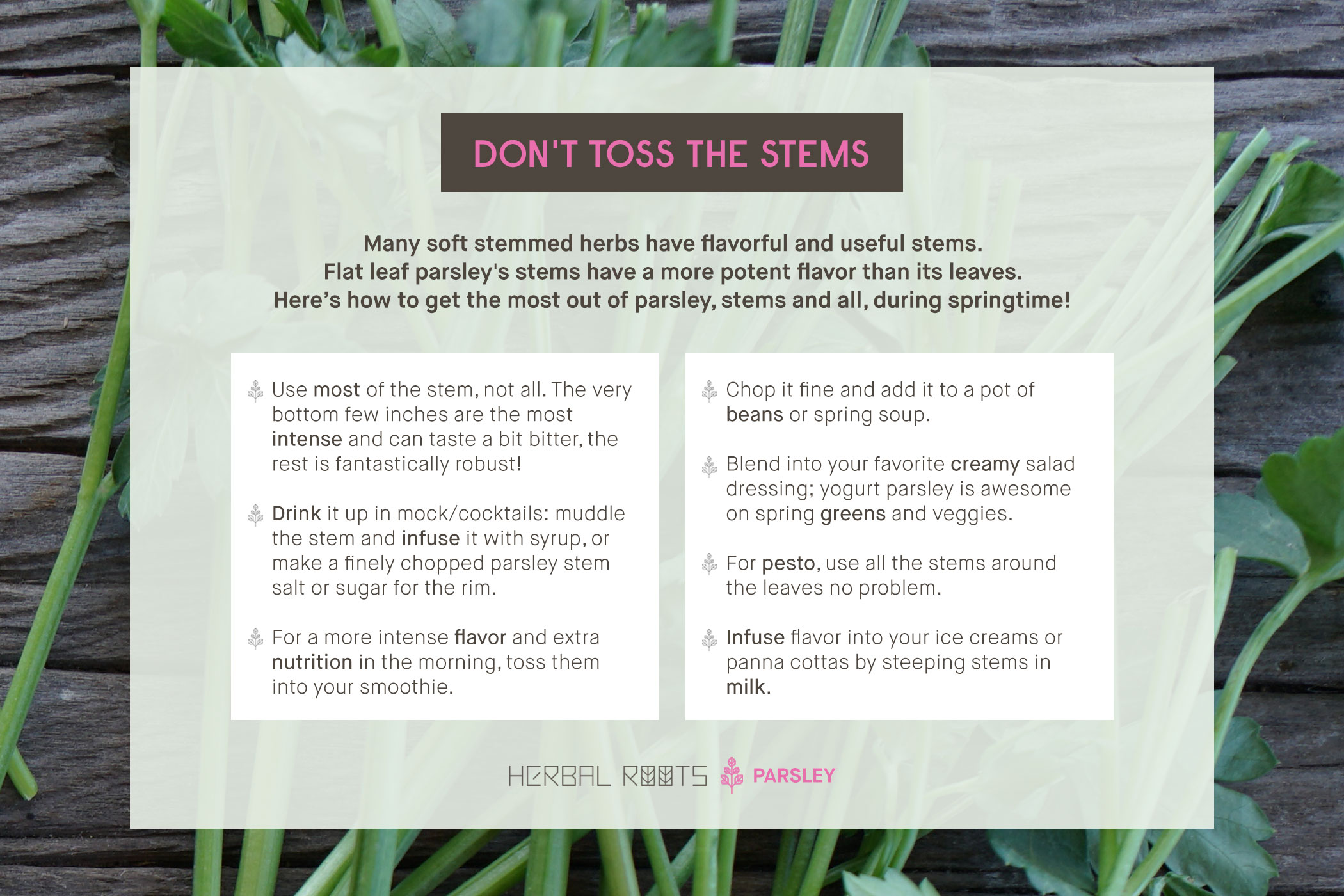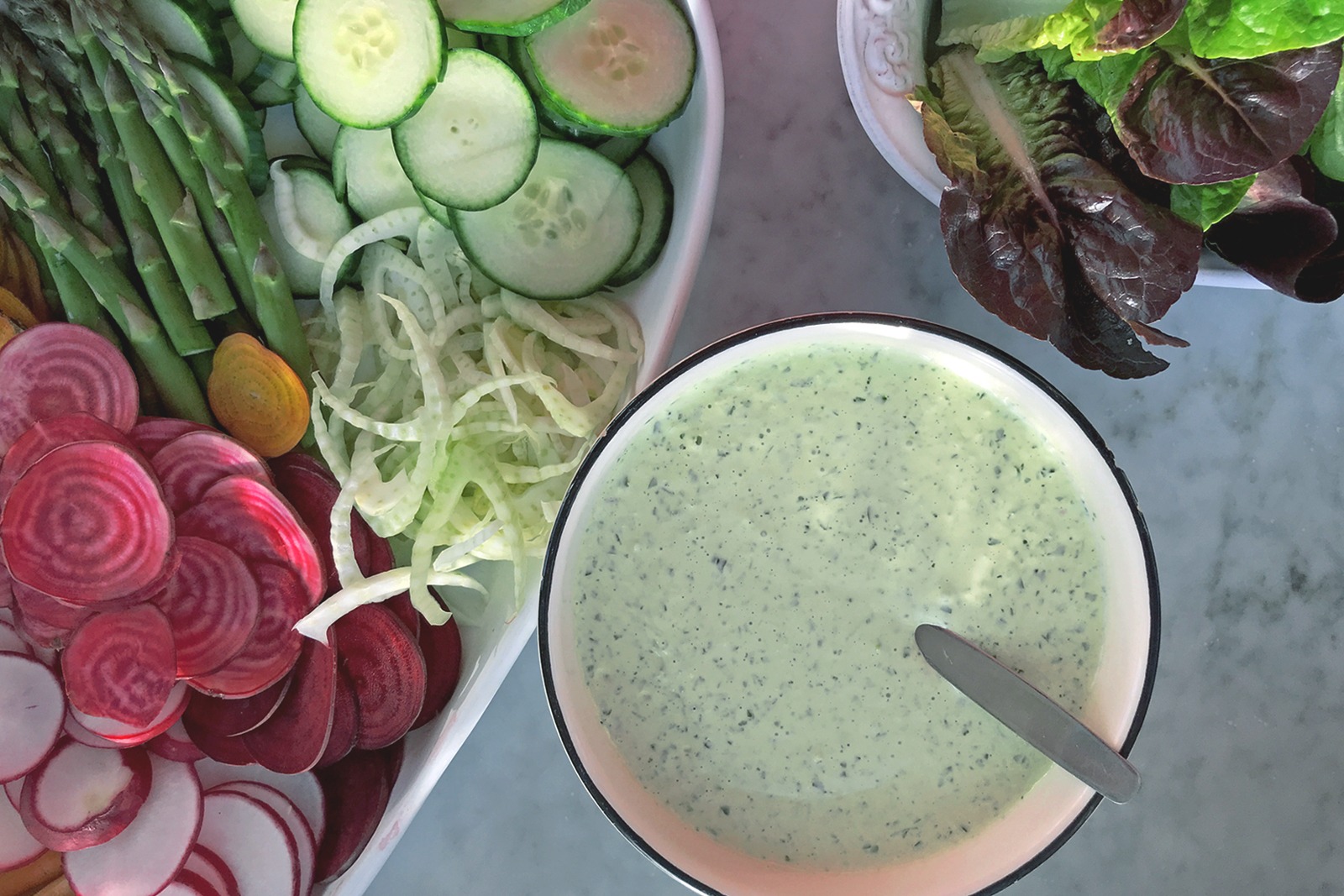Spring Parsley ~ Flat Leaf
APRIL 10TH 2019
Back in Brooklyn someone writing a magazine article once asked me – along with about 10 other food folks – “what is the one ingredient you can’t live without?” Most gave answers like Sriracha, salt, fish sauce, mustard, and good quality extra virgin olive oil. I said parsley. It is the one thing that I never run out of in my kitchen, and, in my mind, parsley is both versatile and one of the best fresh flavor enhancers I know.
I want to make it clear that this article is about the only parsley I recognize, flat leaf parsley. Its nemesis, curly parsley, is an ingredient/figurine I absolutely believe should go extinct. I have nothing against garnish or the power of parsley as a palette and breathe cleanser; I do, however, have a deep problem with growing inedible garnish, and that’s what happens with most curly parsley – it’s never eaten. If not extinct, then it most certainly should not be grown for commercial use, as we should not be growing garnish for the sake of it with our precious soil and lands. This is what people should be spending time thinking about in terms of food waste, much more so than ugly carrots.
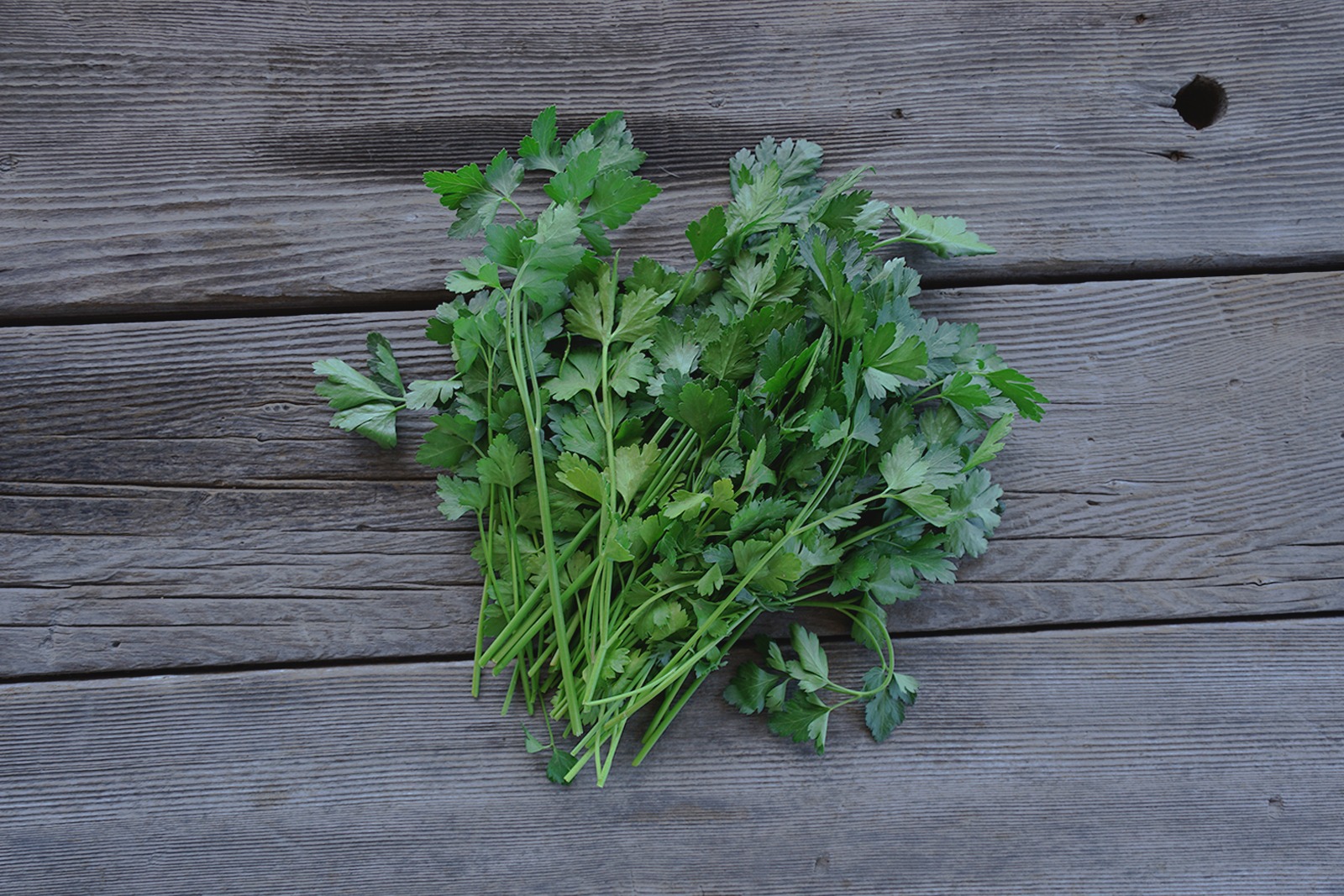
But I digress, let’s get back to the real kind and its virtues…
Parsley is utterly forgiving. Even when it’s past a long time and wilted at the bottom of your veg drawer for 4 weeks after you bought it, it’s still fully usable and flavorful. Which leads me to another one of its virtues: its versatility found in various stages. When it’s fresh off the plant it has a robust flavor, strong character and composition, it’s wonderful in fresh salads raw. The Middle Eastern influence penetrated my cooking repertoire after years of traveling to places like Israel, Palestine, Jordan, Cyrus, Turkey, and Tunisia, where I discovered its versatility and simplicity in raw, fresh form. I simply cannot imagine my life without fresh parsley as a kitchen staple these days, but even after it’s wilted and less fresh from the earth, it’s got this rare and magical ability to add the same fresh flavor when you buzz it up into a sauce, chimichurri or pesto.
Parsley’s flavor adds subtle fresh notes to any dish, with its clean and grassy fresh notes. I love tossing fresh parsley into any dish – cooked or raw – to give the recipe a more herbaceous and fresh quality. I also tend to use it more like a vegetable, bunches and bunches of it. Parsley is great year round and is one of the most acessible of herbs today; it makes an excellent ingredient for almost any spring dish, as it allows the freshness of spring to shine through and speak for itself!
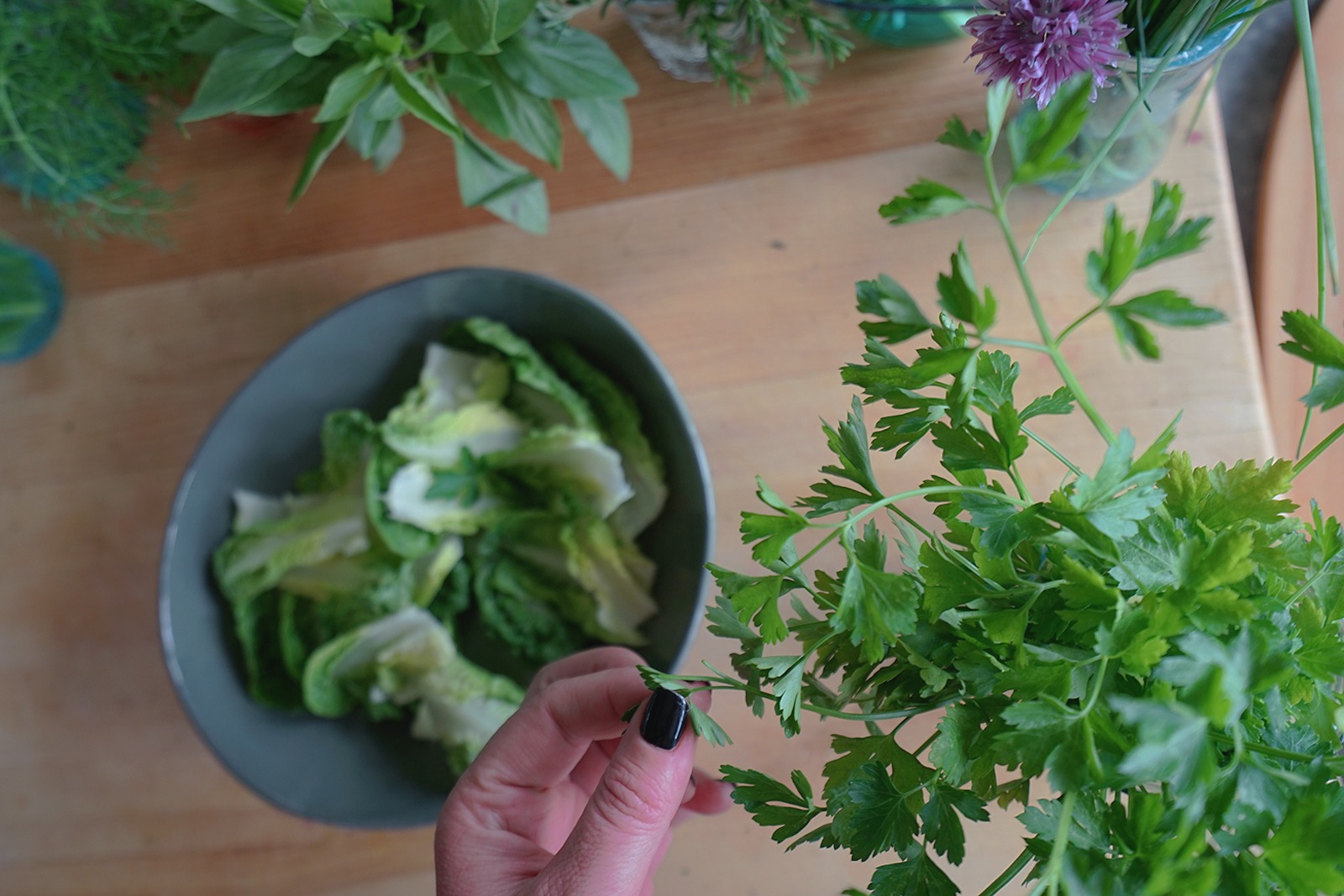
Parsley is gentle, subtle, and almost grassy. It is typically thought of as a “fresh & bright” flavored herb that some say tastes robustly vegetal, but it is mild in comparison to most other herbs. In central and eastern Europe and in western Asia, you’ll find fresh green chopped parsley sprinkled on many dishes, as well as layered inside. The green parsley on top acts as a fresh flavor pop, kind of like flake salt, but offering a grassy, vegetal pop instead. Other parts of Europe favor using parsley as a part of bouquet garni, a grouping of fresh herbs used to flavor stocks, soups, and sauces. Without parsley, the national dish of Lebanon, tabbouleh, would cease to exist. In Argentina it’s chopped along with a variety of ingredients and vinegar and tossed onto steak as the main flavoring agent.
Parsley has a way of enhancing the naturally positive properties of any dish without compromising or overpowering flavors. It also can be the main attraction of any dish: a parsley herb salad or a topping to a flavor, roasted bone marrow with fresh parsley salt, gremolata or parsley pesto to name a few. I love it just as much in sweet concoctions as I do savory. My Meyer Lemon Parsley Cupcakes are a crowd pleaser, as is my Parsley Lemonade, and can you can imagine the idea of a Parsley Lemon Popsicle on a hot spring day?
Everything in the world these days is evolving quickly, the food scene has never been immune to this and that offers immense opportunities to explore, using more fresh herbs – and certainly parsley – in cooking patterns. Fresh herbs are no longer boxed into a season, dish, or flavor. Creativity is key. Knowing the flavors of each is what helps us maneuver.
This spring, I encourage you to play with parsley – boldly and subtly. Explore it in your sweets, cook it into your savory; it’s truly able to do it all and it’s extremely forgiving of “mistakes”, which by the way are often how awesome new dishes and flavors are born. Below are a few of my parlsey-inspired spring favorites.
Buttermilk Parsley Ranch Dressing
You may be aware by now that my childhood was rather unique, my father was rather unique. I remember going to a place called Hidden Valley Ranch in Ventura County and buying hay for our horses. I was old enough (and born to the generation of buying everything processed) so Hidden Valley Ranch dressing was well known to me. When we arrived, I thought we were at the place where the dressing came from; I don’t remember if my father told me it was the same place or not, but it was the greenest, lushest place I had ever seen, hidden in a quaint little valley and it smelled of fresh grass and flowers.
My Parsley Buttermilk Ranch is an ode to this place, much more than the dressing that’s named after it. Also it’s important to note I never buy buttermilk, I always make the closest substitute myself by adding a little lemon juice (or vinegar) to whole milk (or half and half). It won’t give you the same thick creamy texture that store-bought buttermilk gives, but making it yourself can give it the same tangy flavor, and I think it’s always thick enough. It works wonderfully in baked goods, adding the same light airy quality that buttermilk does. I prefer this dressing made by hand as opposed to the blender in terms of flavor, but I do make versions in the blender as well.
Ingredients
Makes 2 cups
1 cup whole milk
1 tablespoon lemon juice
½ cup mayonnaise
2 teaspoons Dijon mustard
1 teaspoon garlic salt
1 teaspoon lemon zest
2 tablespoon grated red onion
1 teaspoon shallot, chopped superfine
2 tablespoons chopped superfine fresh parsley leaves
1 tablespoon chopped superfine fresh dill
1 tablespoon chopped superfine fresh chives
1 chive blossom, flower heads removed, discard stems
1 teaspoon seasonal flake salt
Directions
Place the milk in a cup and add the lemon juice. Let stand for about 10 minutes until thick. Place this mixture in a mixing bowl with the mayonnaise, mustard, garlic salt and lemon zest, and whisk vigorously until it’s smooth, creamy and well mixed. Add the onion, shallots and herbs, and whisk gently until combined. Fold in the flake salt and let sit in the refrigerator for about 30 minutes before serving.
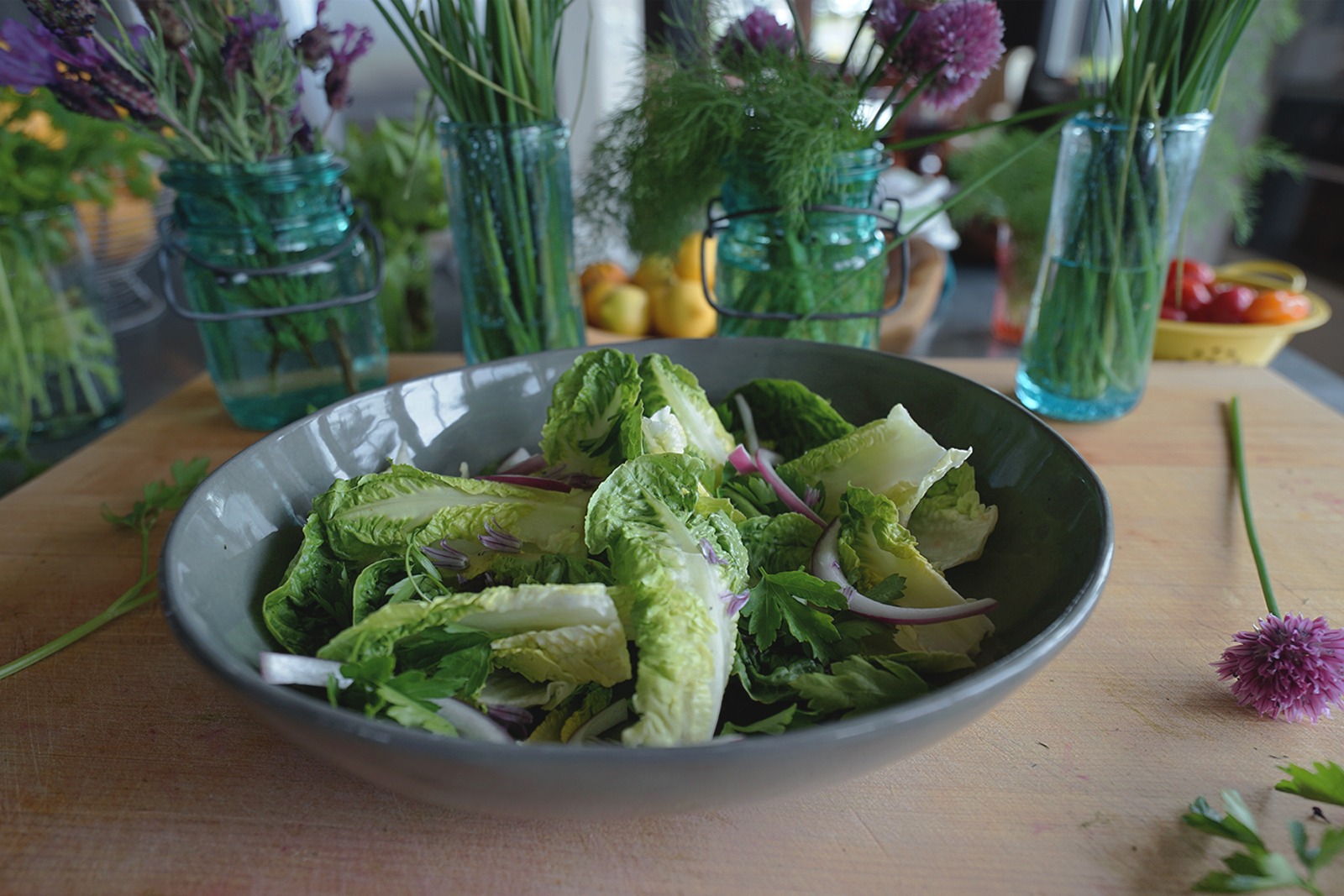
Little Gem Parsley Salad
This is literally just as the title describes; crunchy little gem lettuce paired with parsley leaves and a few chives make one of the simplest and tastiest salad recipes I have ever made. Kids love this salad. I think part of the reason kids don’t like salads is that people often use leafy greens that get soggy; kids are smart, who wants that? Little gem lettuce stays crisp and tastes fresh and yet mild – like lettuce should in my opinion. This salad is excellent with my Buttermilk Parsley Ranch Dressing; and if you are feeling fancy, toasted popped quinoa on top adds the perfect protein-packed crunch. It’s a trick I learned sitting at Brooklyn’s (now closed) infamous tiny local ingredient hotspot, Batterby. I used to be a frequent solo diner back when it first opened, and I learned a lot of tricks watching the pros in its kitchen.
Ingredients
Serves 4-6
3-4 small heads little gem lettuce, cored leaves left whole or torn in half if too large
¾ cup fresh parsley leaves – loose/tight, it doesn’t matter
handful of chives, snipped into ½ inch pieces
small amount of red onion, shaved thin
1 chive blossom, flower heads (petals) only
tablespoon black quinoa (optional)
Directions
Toss together the little gem lettuce and parsley on a large salad plate or bowl. Sprinkle the chives, red onion and chive blossoms over the top. Serve with Buttermilk Parsley Ranch. Add toasted popped quinoa if desired.
To toast and pop the quinoa, place a thin bottomed sauté pan over medium high heat and add the quinoa. It burns easily so make sure to move the pan around a lot and shake it. It should take about 1-2 minutes for the qiunoa to get toasted and pop, like tiny popcorns. Remove once most of it is popped and sprinkle on top of the dressing on the salad.
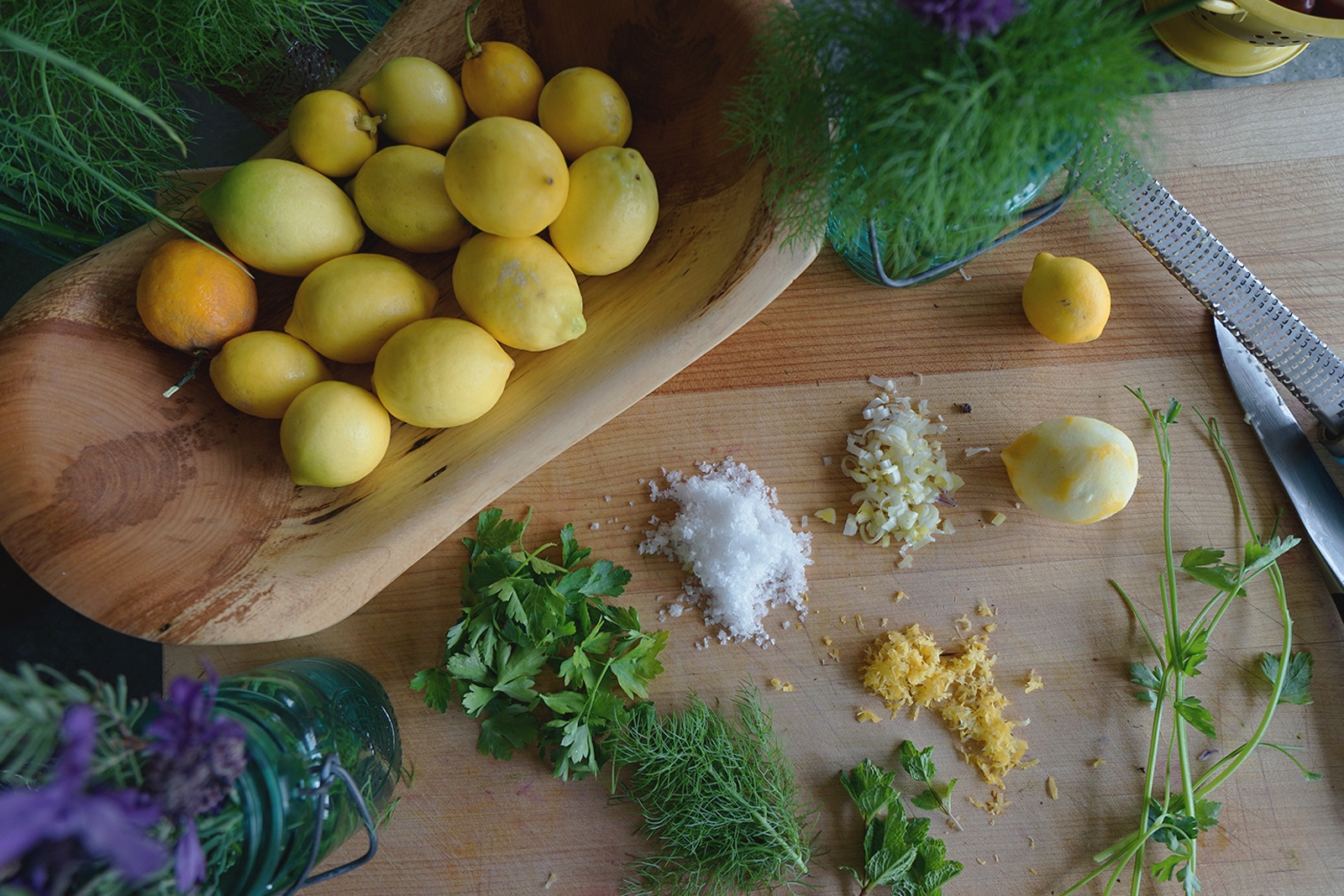
Spring Ossobuco with Parsley Gremolata – Herbal Bone in a Hole
This is probably one of my favorite recipes that I often use for celebration, as I did last year on my birthday, which marked a difficult and yet liberating time in my life. This recipe was born in my Brooklyn days, from my love of fresh shelling peas and upon the first rupture of springs fresh offerings. The greenmarkets in NYC & Brooklyn to this day remain my favorite in the world, and back then, after crazy winters and sometimes amidst 2 feet of snow in April, there was always offerings of local, green and fresh.
This recipe gave me a place to feel warm and comforting yet fresh and airy. It’s not heavy like the more authentic ossobucos, and I don’t use veal shanks because it’s just not necessary and I think, rather cruel. Beef Shanks are perfectly fine and inexpensive, make sure you get the ones that are not cut too thick. Like most of my celebratory dishes and recipes it’s easy to make, forgiving if you talk too much to your friends while making it or drink too much of the wine you were supposed to use for it. The Parsley Gremolata is the perfect addition, it’s like topping it all off with spring.
Ingredients
Serves 6
Kosher salt
6 beef shanks (no more than 4 pounds worth)
½ cup all-purpose flour
2 teaspoons Spring Herb Salt/Pepper Seasoning
1 tablespoon chopped fresh mint leaves
1 teaspoon Aleppo pepper
¼ cup olive oil
2-3 stalks of green garlic, chopped fine
1 tablespoon lemon zest
2 red spring onions, white and green parts both, chopped
1 large carrot, chopped fine
1 small fennel bulk, chopped fine
small handful of fresh fennel fronds, chopped
small handful of parsley leaves, chopped
small handful of tarragon leaves, chopped
small handful chives, chopped
1 cup dry white wine
2 cups onion herb broth or water
10 yellow cherry tomatoes, halved
1 cup fresh shelling peas, shelled
1 cup (aprox) asparagus tips
Herbed Polenta for serving
Parsley Gremolata for topping
Directions
Sprinkle the beef shanks with a little salt and let them come to room temperature. In a small mixing bowl mix the flour, herbal seasoning, mint and Aleppo pepper. Dredge beef shanks in the flour mixture until they are well coated. In a large dutch oven or le creuset on medium high heat, brown the ossobuco on all side or about 2 minutes on each. Take the meat out of the pan and set aside. Reduce the temperature to medium. Sauté the garlic, onions and lemon zest for a few minutes. Add the carrots and the fennel, and sauté a few more minutes. Season with salt, pepper and cayenne, and add the herbs. Mix well and continue to sauté a few more minutes. Season with another teaspoon of the Spring Herb Salt/Pepper. Mix well and continue to sauté. Add the wine and stir well removing any bits stuck to the bottom of the pan. Add the stock or water as well as the tomatoes, and stir well. Add the beef shanks to the pot and cover with the vegetables and juice. Turn the burner to low and braise for about an hour and 20 minutes or until all of the onions are thick and the tomatoes have melted into the sauce. The meat should be “fall apart” tender. Add the peas and asparagus and cook another 5 minutes. Take off heat and serve immediately over pasta or Herbed Polenta with Parsley Gremolata on top.
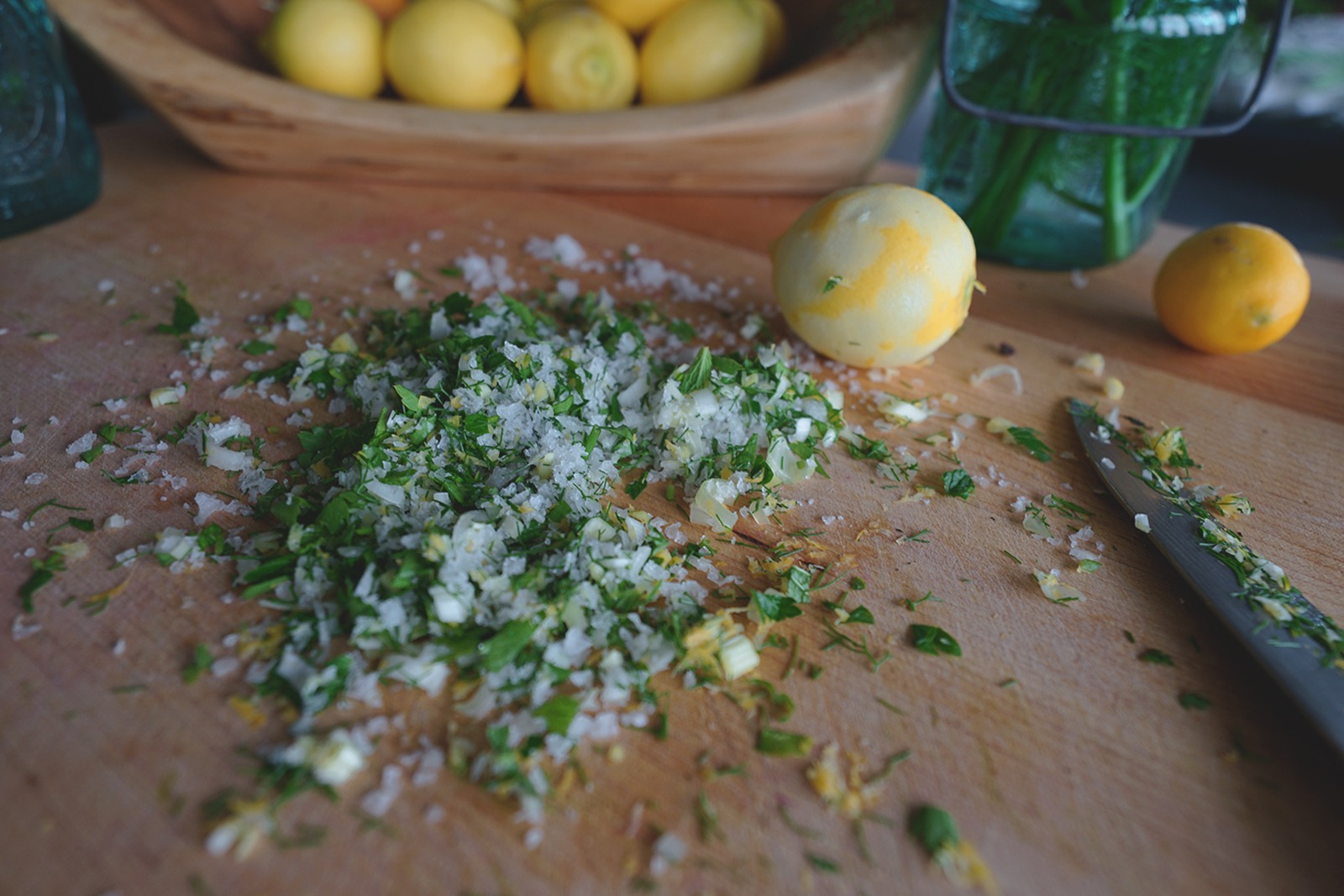
Parsley Gremolata
Ingredients
Makes about ¾ cup
¼ cup chopped superfine parsley leaves
1 tablespoon chopped superfine fennel fronds
1 tablespoon chopped superfine mint leaves
3 tablespoons lemon zest
1 tablespoon chopped superfine green garlic
1 tablespoon Maldon flake salt
Directions
Toss together all of the ingredients until well mixed. Use at room temperature. Refrigerate after use.
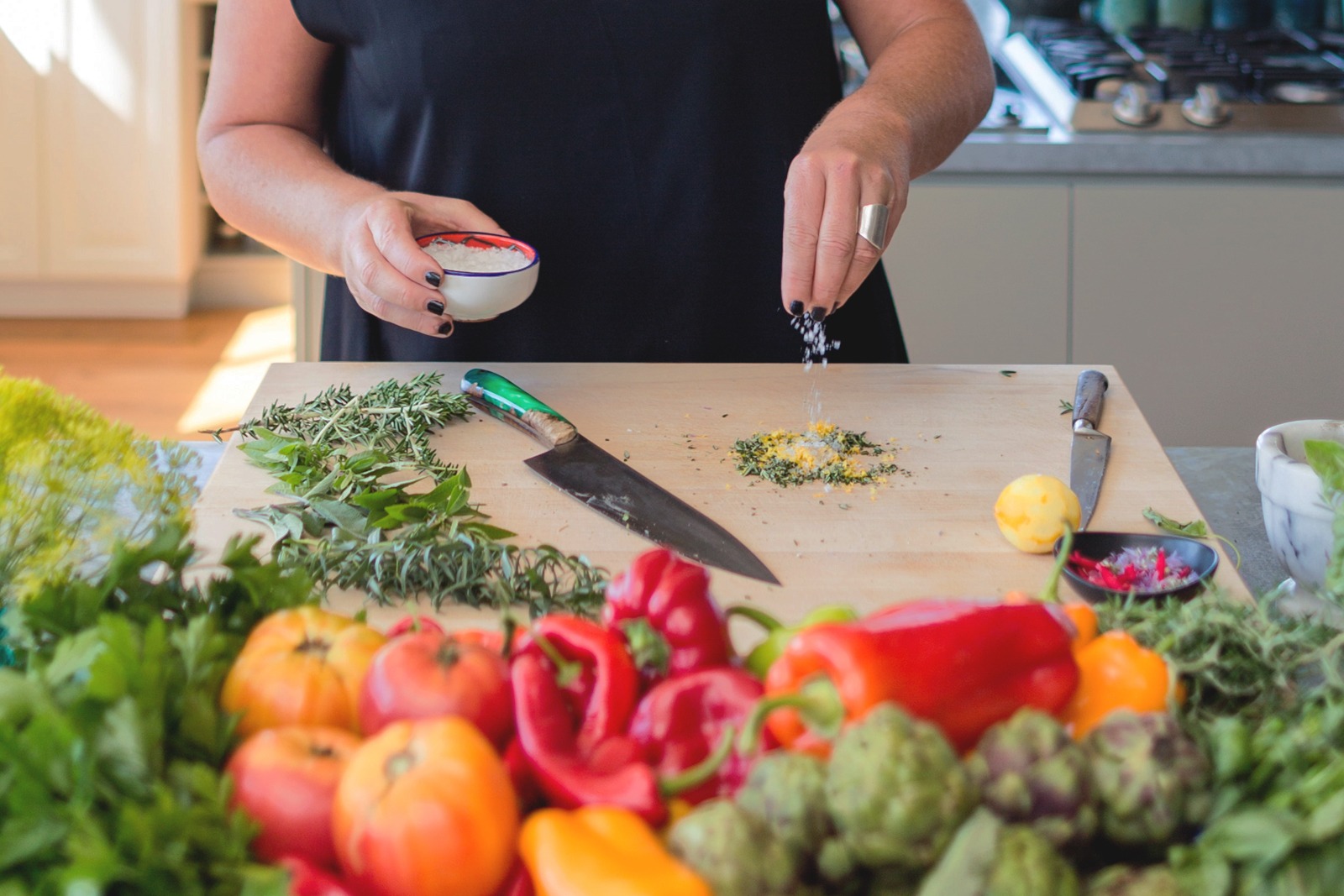
Meyer Lemon Parsley Cupcakes
Parsley is exceptionally versatile and pairs wonderfully with lemons and sweet things. These cupcakes originally came to be because of my obsession with parsley lemon popsicles. The flavor was so fresh and bright that I had to make it into a little cake in order to eat them when it’s not quite hot enough for popsicles. This also makes a beautiful and fancy cake for a special occasion.
Ingredients
Makes 12-24 cupcakes
2 tablespoons Meyer lemon zest
2 cups sugar
3 cups all-purpose flour
2 teaspoons baking powder
1 teaspoon baking soda
3 sticks of butter, softened
4 eggs, eggs
1 teaspoon vanilla extract
1 ¼ cups buttermilk
¼ cup Meyer lemon juice
Parsley Lemon Icing
Directions
Preheat oven to 350°F. Generously grease, using butter, two small sized muffin tins, or 1 big one (you can also use the cupcake liners or silicon molds). Combine the sugar and zest, and using your fingers, rub the zest and sugar together and mix, flavoring the sugar deeply with the lemon zest. In a separate bowl, sift together the flour, baking powder and baking soda and set aside. In a stand mixer (or by hand – the mixer just ensures its super light and fluffy), combine the butter and sugar mixture and beat on medium high speed until light and fluffy. Add the eggs and mix again until very creamy, still on medium high speed. Add the vanilla, buttermilk and lemon juice, and mix up one last time, making sure everything is mixed up and the batter is creamy and smooth. Divide the batter up into your greased muffin tins and place in the oven to bake for about 25 minutes, or until the tip of a sharp knife inserted comes out clean. Cool completely on a wire rack before removing cupcakes. Ice with the Parsley Lemon Icing.
Parsley Lemon Icing
Ingredients
Makes 2 cups
¼ cup sugar
1 tablespoon lemon zest
2 tablespoons chopped fine parsley leaves
1 tablespoon lemon juice
2 sticks (1 cup) butter, softened
2 cups powdered sugar
pinch of salt
Directions
Mix the sugar, lemon zest and parsley in a small bowl with your fingers, rubbing the zest, herbs and sugar together to flavor the sugar deeply. Add the lemon juice and mix well. Combine the lemon zest and juice mixture with the butter in a stand mixer and mix on medium high speed until the butter is totally shipped and the parsley mixed in. Add the powdered sugar, ½ cup at a time while the mixer on medium low speed, making sure to scrape down the sides of the mixer bowl in-between. Once all the powdered sugar is in, mix it a little bit more on medium high speed, making sure the icing is smooth and whipped. Frost cooled cupcakes. Decorate cupcakes with some Parsley Sugar Gremolata.
For the Parsley Sugar Gremolata, mix up some sugar, chopped parsley leaves and lemon zest, rubbing together with your fingers. Sprinkle on anything that needs a fresh, sweet grassy note.



